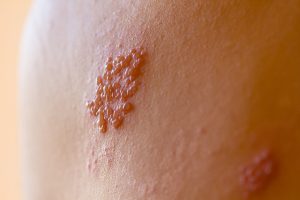
Shingles – causes, side effects and treatments at NaturalPedia.com
Thursday, June 21, 2018 by Ralph Flores
http://www.naturalpedia.com/shingles-causes-side-effects-and-treatments-at-naturalpedia-com.html

Shingles, also referred to as herpes zoster, is caused by the varicella-zoster virus (human herpesvirus type 3), which also causes chickenpox. To note, chickenpox is the acute invasive phase of the virus, while shingles is the reactivation in its latent phase. The condition causes an inflammation of neurons called sensory root ganglia and the skin around the affected ganglion, as well as the gray matter, meninges, and dorsal and ventral roots.
The Centers for Disease Control and Prevention estimates that at least one million people are infected with shingles per year. In particular, those who have recovered from chickenpox are prone to developing shingles, even children.
For the most part, people who are at risk for shingles can have only one episode during their lifetime.

Known risk factors and symptoms of shingles
People who have been infected with chickenpox are at risk for getting shingles; however, the risk is higher in older adults, as the condition is common in people who aged 50 years and older. Those who have compromised immune systems – including those with immune system diseases like HIV/AIDS, those with certain cancers, and those who are taking immunosuppressive drugs after an organ transplant – are more likely to get shingles. Those who have an infection or are stressed are also at risk of getting the condition.
A person who is infected with shingles will feel the following symptoms before the breakout.
- A tingling or painful sensation on the skin
- Headaches and a general feeling of malaise
Shingles usually appear on the chest and abdomen, but it can also appear on the eyes, face, and genitals.
Body systems affected by shingles
The following complications can arise from shingles.
- Postherpetic neuralgia – If shingles results in damaged nerve fibers, this can cause it to send confused and exaggerated messages of pain from the skin to the brain.
- Loss of vision – This occurs if the condition affects the eyes, leading to painful eye infections
- Neurological problems – Depending on the damaged area, this can either lead to an inflammation of the brain, as well as facial paralysis and hearing or balance problems.
Food items or nutrients that may prevent or relieve shingles
Some recommended food items to manage shingles include the following.
- Fruits and vegetables provide the body with nutrients to boost and maintain the immune system.
- Garlic contains antiviral and anti-inflammatory properties and relieves pain related to the condition.
- Seaweed can reduce post-herpetic pain felt after shingles.
- Whole grains have fiber to help with digestion that can benefit health.
- Water, of course, flushes out the virus from the system.
Treatment and management options for shingles
People in cool climates who have been affected by chickenpox should be careful when going to a very warm climate (i.e., to go on a vacation) as sudden exposure to heat and sunshine can increase the risk of shingles.
In general, it’s also wise to avoid food items that contain arginine as this is linked to increased recurrences. Some food items include chocolate, cola, beer, grain cereals, chicken soup, gelatin, seeds, nuts (especially peanuts), and peas.
Acupuncture could also be used to relieve the condition, as there are certain techniques devised to address shingles.
Where to learn more
- Treating shingles with homeopathy
- Shingles vaccine made with pig gelatin, MSG and residual components of human DNA from an aborted fetus. Why?
- From vitamin C therapy to acupuncture: Natural ways to prevent and ease shingles
- Wipe out shingles FAST with easy-to-use homeopathic remedies – relieve pain, eliminate burning, itching and infection
- Trading chickenpox for shingles
Summary
Shingles is caused by the varicella-zoster virus (human herpesvirus type 3), which also causes chickenpox.
Shingles causes an inflammation of the sensory root ganglia, as well as the gray matter, meninges, and dorsal and ventral roots.
People who have been infected with chickenpox are at risk of getting shingles.
Sources include:
Tagged Under: Tags: shingles





